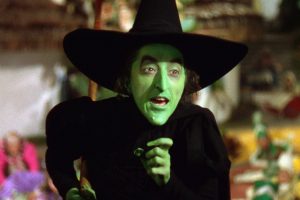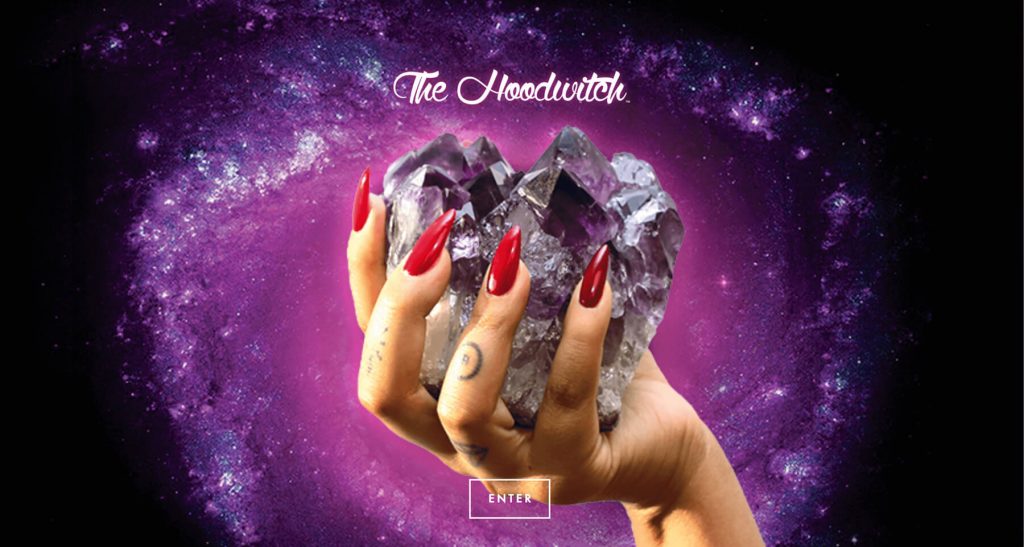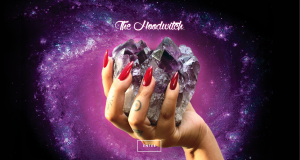Starbucks recently introduced a “Crystal Ball Frappuccino,” presumably hoping for a sequel to its wildly successful Unicorn Frappuccino.
Here is Starbucks’ Crystal Ball Frappuccino Instagram post from March 22, 2018:
This Starbucks ad is clearly based on the distinctive images produced by Bri Luna, aka The Hoodwitch, for her web site, social media, and various collaborations.
Bri Luna is a distinctive witch. Her look, style, writing, and images do not fit popular stereotypes about what witches look like, what they wear, or how they act. Luna troubles the definition of “witch” and expands it to be more broadly inclusive. She’s intersectional and inspirational.
But Luna was not remunerated, consulted, or in any way involved in the production of the Starbucks ad. Understandably, Luna was pissed, as were her Instagram followers and fans.
Granted, most witchy imagery isn’t distinctive enough to merit this level of outrage. The stereotypical witch aesthetic is culturally pervasive – and thus ineligible for copyright protection – at this point in time. But black brujas with witchtips, a predilection for saturated colors, a penchant for glitter, and love of neon haven’t exactly reached critical mass on the internet or in the popular imagination. If Starbucks had gone with a black cloth, silver jewelry, and a milk-white hand, I’d probably be on their side.
But they didn’t.
If I say “crystal ball,” you’re likely to think “witch” or “fortune teller.”

If I say “witch,” you may think green skin, hooked nose, pointy hat, enjoys the company of flying monkeys.

If born after 1975, pale skin, black-clad, silver jewelry, dark lipstick, and a scowl may come to mind.

If you’re into millennial witchcraft, you may also think Free People, tarot apps, and palo santo perfume.

You probably don’t think:
or this:
It’s hard to call anything or anyone “original” in the twenty-first century, but Luna is one of the few people I laud with that accolade. Luna has greatly expanded what it means to be a witch. (So have lots of other witches, in lots of different ways, but that’s a different post.)
Yet, witchcraft remains a fairly small community, its internal aesthetic debates are not known to the broader public, and the singularity of Luna’s imagery is not likely to register with most Starbucks customers.
Thus, prospective Crystal Ball Frappuccino buyers aren’t likely to see the Starbucks ad above and think, “Hey, that looks like Bri!” They’re likely to think, “Oooo, that’s looks magical, fresh, colorful, sweet, and kind of badass.” But “magical, fresh, colorful, sweet, and [totally] badass” is Luna’s brand, her imagery, her vibe. And it’s highly distinct from other magical practitioners.
And that’s why Starbucks’ behavior sucks.
Ripping off an artist’s images to sell corporate coffee is poor form.
Riffing on witchcraft to sell corporate coffee is worthy of an eye roll, but this is not the first time that mysticism has unwittingly served capitalism.
Jacking an African-American-Mexican bruja’s photographs, concepts, and style, which have greatly changed how the witchcraft community sees its members, but are mostly unknown to the broader public…that’s a multi-pronged abuse I can’t dismiss.
Legally, it’s tough. Hypothetically, were Luna to sue Starbucks, a court would look at specific similarities between the Starbucks image and Luna’s images. There are plenty. Thus, most courts would consider “substantial similarity” and “total concept and feel” – a doctrine developed for situations such as this one.
When considering total concept and feel, a judge is invited to consider both “intrinsic” and “extrinsic” elements.
“Extrinsic” elements are defined as “the type of artwork involved, the materials used, the subject matter, and the setting for the subject.” [Sid & Marty Krofft Television Productions, Inc. v. McDonald’s Corp., 970 F.2d 106 (9th Cir., 1977)] But…“Obviously, no principle can be stated as to when an imitator has gone beyond copying the ‘idea,’ and has borrowed its ‘expression.’ Decisions must therefore inevitably be ad hoc.” [Sid & Marty Krofft Television Productions, Inc. v. McDonald’s Corp., 970 F.2d 106 (9th Cir., 1977), citing Peter Pan Fabrics, Inc. v. Martin Weiner Corp., 274 F.2d 487, 489 (2 Cir. 1960)] Translating this legalese: things can get fuzzy.
“Intrinsic” elements concern the judgment of “an ordinary person” when the expression of the works are compared. The comments on Starbucks’ Instagram post are divided, and suggest that witches see too much similarity, while non-witches don’t see a problem. Thus, we’re left with a question: who is the ordinary person? Someone familiar with Luna’s imagery or someone who is not? (Get nerdy about the identity of the “ordinary person” with me in the comments – it’s definitely an open question.)
I’m sure another lawyer could argue that the elements in each image are so simple that “total concept and feel” doesn’t apply. Or that the ordinary person is a non-witchy type who wouldn’t see Luna’s imagery as distinctive. But I think the Starbucks image clearly bites Luna’s style, in a way that might rise to the level of infringement. (And, before you ask, fair use absolutely does not apply here, as the Starbucks image has no purpose consistent with fair use.)
As you can see, the legal answer is a bit messy. But, ethically, it’s pretty straightforward.
Starbucks, a multinational corporation, decided to mimic imagery from an independent artist who belongs to numerous minority groups – African-American, Latina, witch – and seemed to think she wouldn’t fight back, that her fans wouldn’t notice, and that consumers wouldn’t care. (Given my interactions on Instagram, 1 out of 3 of my assumptions seem to be correct: Becky just wants her Frappuccino.) This is an abuse of power and this is wrong.
Starbucks most likely paid someone to source and create imagery for the ad. If they liked Luna’s work so much, they should have asked her to direct the project, take the photographs, or style the ad. At minimum, Starbucks should have credited Luna as the inspiration for the Instagram spot. And it’s all much worse because Luna actually lives in Seattle and has a robust online presence. She isn’t hard to find.
Finally, Starbucks posted the ad to Instagram, one of Luna’s primary modes of interaction, with no credit. Even a nod – “Inspired by @thehoodwitch” – would have gone a long way towards mollifying Luna’s fans (if not Luna herself). However, they would never do this, because it could weaken Starbucks’ position should Luna sue them for infringement. Which, frankly, should make you more suspicious than anything I’ve said so far.
As I’ve discussed before, there is aware appropriation and there is sterile appropriation. (The terms are Jaron Lanier’s and if you haven’t read his book, go do that right now.) Aware appropriation uses pre-existing material in ways that enliven the images or information, creating a new lens for the viewer or reader. It takes thought, feeling, and effort to be an aware appropriator. Sterile appropriation, on the other hand, repurposes pre-existing material in ways that are flat, serve only the appropriator, and have no intelligent effect on the audience’s engagement with the pre-existing material. Corporations almost always engage in sterile appropriation, but with a modicum of effort, entities like Starbucks can use their colossal influence in more positive ways.
It starts, as you might imagine, with crediting – and paying – artists like Bri Luna.


